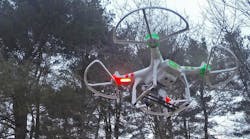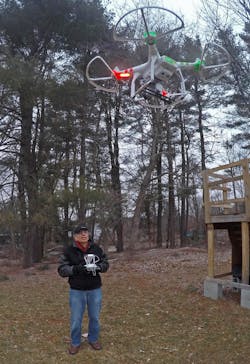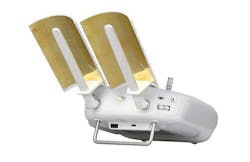It has been two years since I began flying a quad-rotor drone, a DJI Phantom 3 Advanced. My family gave it to me for a birthday marking another decade on the planet, as well as to extend my interest in landscape photography. Thus I feel qualified to offer some views of drone ownership, operation, and dealing with the Federal Aviation Administration (FAA) from a perspective based on my background as an engineer.
First, it should be noted that Phantom control range is given by DJI as roughly one-and-a-quarter miles (2 km)—thanks to the controller operating at 2.4 GHz with an FCC transmitter power (EIRP) of 20 dBm. FAA regulations require that the drone remain in view of the pilot or spotter and not fly above 400 ft. altitude AGL (above ground level). But with an aircraft a bit less than a foot square in planform area and not even eight inches high, maintaining unaided visual contact is problematic well short of transmitter range. I have even lost sight of my drone at distances of only a couple hundred feet against a confusing background of rock faces in a river gorge.
Now, some pilots use range extending antenna reflectors—both jury-rigged foil jobs and ones commercially available—to expand their operating area. Unless a spotter with optical equipment is on hand, such operation is pushing beyond the limits of legal flying, leading to more negative drone incidents.
Situational Awareness
In addition to keeping the drone in sight, obviously the aircraft camera display on the controller (for the Phantom 3, this is either a smart phone or tablet) aids in determining aircraft position and orientation. But this view is restricted to dead ahead. As happens to me in vast wooded areas, determining exact drone direction is only possible if distinct features are visible. Once a desired spot in the sky is reached, a couple of control inputs and the responses observed allow aircraft orientation to be determined.
With the camera lacking peripheral vision, objects off to the side might pose a collision hazard. Again a spotter is useful if the pilot is concentrating on the camera display, as I found vital in avoiding branches when imaging waterfalls in a forest. Once, not having an extra pair of eyes looking at the drone, I saw on the display I was heading for a birch tree. Backing away I failed to see there were branches behind the aircraft—with the resulting impact dropping the Phantom into a pond.
Fortunately the water was shallow, and a canoe rescue led to recovery. Attesting to the ruggedness of the DJI design, a couple of days to dry out was all that was needed to be in the air again—although the prolonged water immersion must have shorted the battery, which was unable to be recharged. (That crash was my second major accident with the Phantom 3. Earlier while hovering across from the top of a 200+ ft. tall waterfall, the drone threw a prop. It tumbled down, impacting on some rocks; pieces went flying and the battery ejected. The battery was quickly recovered from the stream, and again with some drying, along with epoxy, we were airborne once more!)
A Leap of Technology
The latest DJI technology iteration, the Phantom 4 Pro, integrates collision avoidance features to sidestep such misadventures. Included are stereo vision positioning via twin imagers, pointing fore, aft, and below (the latter with ultrasound backup). To each side, infrared time-of-flight sensing is used. The 4 Pro has camera upgrades and numerous automatic flight modes added as well. This could well be my next machine after selling my earlier version.
I also learned the value of GPS-based return-to-home capability in another incident. Trying for some stick time in winds that were near the Phantom control limit (22 mph), the flight was uneventful, until it climbed through 300 ft on the way to maximum altitude. In an instant, a wind shear snatched the aircraft and I could hear the motors screaming to maintain position. As I watched the drone vanishing at an ungodly rate, I slammed the down stick to try and bring it below the shear, followed by hitting the return-home button.
With no sign of the aircraft, I figured it was overwhelmed by the wind and lost…until after what seemed an interminable time, the hum of the motors was heard, louder and louder. Thank you, GPS signal processing and computer power technology.
Drones vs. FAA
No drone discussion would be complete without noting operating under FAA regulations. Until earlier this year, all US drone owners were required to register with the agency. A court decision eliminated this mandate, putting operations “up in the air,” as it were, until any replacement rules are promulgated.
If using a drone for commercial purposes, a pilot has to pass an exam known as Part 107 (for a $150 fee). Unfortunately, the agency has a wide definition of “commercial.” If I take a picture which later is entered and wins a contest for prize money, then I become commercial—and thus illegal. Taking video for a friend or agent selling a house (even if unpaid) likewise makes me commercial. The agent could even be fined for just using video from a non-commercial operator.
If I am flying under 400 ft, more than five miles from an airport (meaning control tower notification is not required), not in restricted airspace, keeping the drone in view, and following other safe procedures (e.g., not over groups without their permission), then it should be none of the FAA's business what I do or how I use any images or video. Part 107 mainly covers regulations near airports, or in esoteric situations like flying distant from the coast—an excessive burden on most “prosumer” drone flyers not in those situations.
While irresponsible drone operators should rightly be punished, little is heard about piloted aircraft flying below their altitude limit of 500 ft., which I have seen often enough to be alert when droning.



